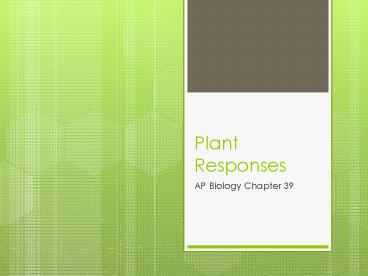Plant Responses PowerPoint PPT Presentation
1 / 24
Title: Plant Responses
1
Plant Responses
- AP Biology Chapter 39
2
Respond to the environment
- Plants have cellular receptors that detect
changes in the environment
Potato grown in the dark w/ long shoots
Potato after exposure to light
Etiolationadaptions for growing in darkness
De-etiolationadaptions for growing in light
(greening)
3
Signal Transduction Pathways (involved w/
de-etiolation)
- Reception
- Extracellular chemicals change the shape of
membrane proteins - Phytochrome in cytoplasm
- Transduction
- Second messengers (small molecules) amplify the
signal and transfer it from receptor to other
proteins to carry out the response - Cyclic GMP Ca2 activate kinases, cytoskeletal
proteins, or specific ion channels (phosphotases
turn things off) - Response
- The product of the transduction regulates
the gene expression and
usually increased enzyme
activity or activated transcription
factors
4
LE 39-3
CELL WALL
CYTOPLASM
Reception
Transduction
Response
Signal Transduction Pathways
Activation of cellular responses
Relay molecules
Receptor
Hormone or environmental stimulus
Plasma membrane
5
Phototropism
- Plant response towards light (positive) or away
from light (negative) - Tropism is plant growth towards or away from
stimuli
6
LE 39-5b
Darwin and Darwin (1880)
Phototropism occurs only when the tip is
illuminated!
Light
Base covered by opaque shield
Tip covered by trans- parent cap
Tip covered by opaque cap
Tip removed
7
LE 39-5c
Phototropism occurs when the tip is separated by
a permeable barrier but not an impermeable barrier
Boysen-Jensen (1913)
Light
Tip separated by mica
Tip separated by gelatin block
8
Frits Went Experiment
Agar block gathered chemicals from tip over time.
When place directly on top, the grass grew
straight. When place to one side, the grass bent
on the side opposite the chemical. The chemical
was named AUXIN!
Dark
Light
9
Gravitropism
- Plant response to gravity
- Roots undergo positive whereas shoots undergo
negative
10
(No Transcript)
11
Thigmotropism
- Plant response to touch
- Sensitive plant (loss of turgor pressure in plant
motor organs causes leaflets to fold together
quickly) - Tendrils of many vines climbing plants coil
around objects
12
Hormones
- Control growth development of plants
- Signaling molecule produced in small amounts in
one part of an organism and sent to other parts
where it binds to a receptor and triggers
responses
13
Auxin
- a hormone that promotes cell elongation
- Responsible for phototropisms (due to unequal
distributions) - Enhances apical dominance (suppresses the
development of axial buds) - Indoleacetic acids (IAA) is a naturally occurring
auxin. - In rooting powder it causes faster root
development - In strong doses can be a weed killer
- Synthetic auxins can induce a tomato plant to
make fruit without pollination (seedless)
14
Cytokinins
- Interact with auxins to stimulate cell division
(cytokinesis) and cell differentiations - Also delay senescence (aging) by inhibiting
protein breakdown - Produced in roots and travels up with xylem sap
15
Gibberellins
- Act in concert with auxins to promote stem
elongation - Induces bolting
- Rapid growth of a tall flower stalk ensuring
pollination seed dispersal - Also causes seeds to break dormancy after seed is
imbibed with water
16
Abscisic Acid (ABA)
- Inhibits growth
- Promotes seed dormancy until conditions are
favorable (enough water to wash away or prolonged
exposure to light or cold weather deactivate it) - Ratio of ABA to gibberellins determines seed
dormancy or germination - Drought tolerance
- Stomates closes
Insufficient ABA in tomato seeds
17
Ethylene
- Gaseous hormone responsible for effects caused by
stress, senescence, leaf abscission fruit
ripening - Triple Response growing tip runs into rock,
ethylene gets released, stem elongation slows,
stem thickens, stem begins to grow horizontally
until amount of ethylene lessens (no more hard
surface). - Senescence programmed death of certain cells or
organs or the entire plant, but will salvage
materials if possible (Apoptosis) - Leaf abscission leaves falling off and a scar
forms to protect the tree - Fruit ripening fruits will mature in the
presence of ethylene (Positive Feedbackmore
ripening causes more ethylene production) - Fruit sellers pick perishable fruit early and
then spray it with ethylene when they are needed
to ripen.
18
(No Transcript)
19
(No Transcript)
20
(No Transcript)
21
Response to Light
- Blue light photoreceptors
- Initiate phototropism light-induced opening of
stomata - Phytochromes (red light)
- Regulate, De-etoiliation, seed germination,
shade avoidance - In seed germination the last flash of light
determines the responseredgerminate
far-redinhibition - In shade avoidance the ratio of red to far-red
can tell the plant to grow taller or to grow more
laterally to maximize photosynthesis
22
Plants Biological Clocks
- Plants have circadian rhythms too!
- Whether in constant light or dark
- The ratio of phytochrome red to far-red helps the
plant reset its biological clock (like us
adjusting to jet lag) - Photoperiodism is a physiological response to
photoperiod (lengths of night day)
23
Response to Dangers
- Against herbivores
- Can have thorns
- Can produce distasteful or toxic compounds
- Some can even recruit predatory animals
- Against pathogens
- Primary defense is epidermis/periderm
- Secondary defense is recognition of pathogen
derived molecules called elicitors by R (disease
Resistant) proteins - Hypersensitive response causes cell tissue
death near the infection site - Systemic Acquired Resistance substance is
produced around infection site and sent by phloem
throughout the plant that activates a signal
transduction pathway that induces resistance to
pathogens
24
(No Transcript)

